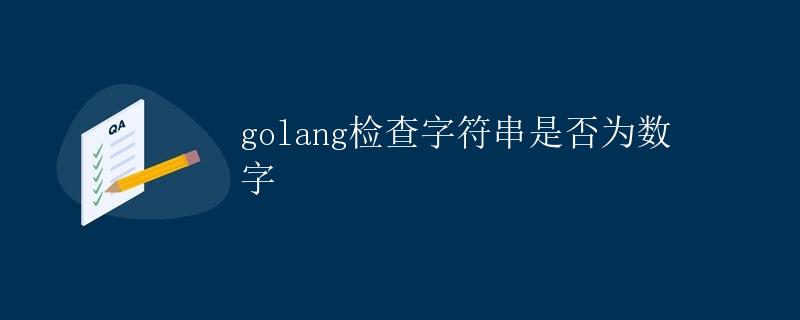Golang检查字符串是否为数字

在开发中,经常会遇到需要判断一个字符串是否为数字的情况。在Golang中,我们可以通过一些方法来判断一个字符串是否为数字。本文将详细介绍在Golang中检查字符串是否为数字的方法。
使用strconv包的Atoi函数
Golang中的strconv包提供了一些用于字符串和基本数据类型之间的转换函数。其中,Atoi函数可以将字符串转换为整数,如果字符串不是合法的整数格式,则会返回一个错误。
下面是使用Atoi函数来检查字符串是否为数字的示例代码:
package main
import (
"fmt"
"strconv"
)
func isNumeric(str string) bool {
_, err := strconv.Atoi(str)
return err == nil
}
func main() {
str1 := "123"
str2 := "abc"
fmt.Printf("%s 是否为数字: %t\n", str1, isNumeric(str1)) // 输出true
fmt.Printf("%s 是否为数字: %t\n", str2, isNumeric(str2)) // 输出false
}
运行上述代码,输出如下:
123 是否为数字: true
abc 是否为数字: false
通过调用isNumeric函数,我们可以判断一个字符串是否为数字。如果字符串为数字,则返回true,否则返回false。
使用正则表达式判断
除了使用strconv包之外,我们还可以使用正则表达式来判断一个字符串是否为数字。在Golang中,可以通过regexp包来操作正则表达式。
下面是使用正则表达式判断字符串是否为数字的示例代码:
package main
import (
"fmt"
"regexp"
)
func isNumeric(str string) bool {
reg := regexp.MustCompile(`^[0-9]+$`)
return reg.MatchString(str)
}
func main() {
str1 := "123"
str2 := "abc"
fmt.Printf("%s 是否为数字: %t\n", str1, isNumeric(str1)) // 输出true
fmt.Printf("%s 是否为数字: %t\n", str2, isNumeric(str2)) // 输出false
}
运行上述代码,输出如下:
123 是否为数字: true
abc 是否为数字: false
通过正则表达式,我们可以指定一个数字的模式,然后用MatchString函数进行匹配,从而判断一个字符串是否为数字。
使用unicode包判断
除了上述方法,我们还可以使用Golang中的unicode包来判断一个字符串是否为数字。在unicode包中,提供了一些用于判断字符属性的函数。
下面是使用unicode包判断字符串是否为数字的示例代码:
package main
import (
"fmt"
"unicode"
)
func isNumeric(str string) bool {
for _, r := range str {
if !unicode.IsDigit(r) {
return false
}
}
return true
}
func main() {
str1 := "123"
str2 := "abc"
fmt.Printf("%s 是否为数字: %t\n", str1, isNumeric(str1)) // 输出true
fmt.Printf("%s 是否为数字: %t\n", str2, isNumeric(str2)) // 输出false
}
运行上述代码,输出如下:
123 是否为数字: true
abc 是否为数字: false
通过遍历字符串中的每个字符,然后利用IsDigit函数判断字符是否为数字,我们可以判断一个字符串是否为数字。
结语
本文介绍了在Golang中判断一个字符串是否为数字的几种方法,包括使用strconv包的Atoi函数、正则表达式和unicode包。开发者可以根据实际需求选择合适的方法来判断字符串是否为数字。
 极客教程
极客教程